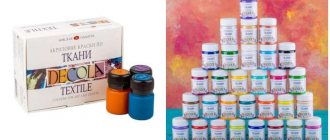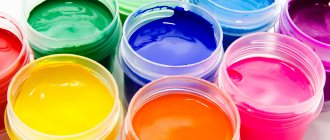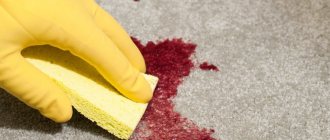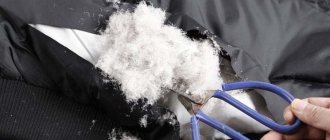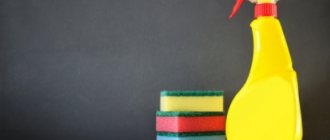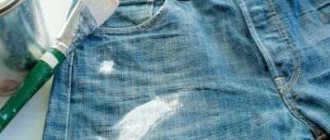Date: 10/24/2017
What to do if you don’t want to part with your favorite things, but they have already lost their original appearance and become faded? There is only one way out; they can be repainted. The question is especially often asked on forums: how to dye jeans in a washing machine? This procedure scares some housewives, but it is worth saying that there is nothing complicated about it. The main thing is to choose the right paint for dyeing clothes and follow all the recommendations indicated on the packaging with the coloring composition.
Types of fabrics for dyeing
Not all fabrics can be dyed a different color.
You can dye items from the following fabrics included in clothing in a different color:
- The first fabric is nylon. This fabric can be painted using powder paint. This fabric also absorbs dye very quickly.
- The second fabric, or fabrics, are natural, that is, linen, silk, cotton, wool, wool mixture. The peculiarity of fabrics made from natural dyes is that such fabrics are dyed very quickly, and the color lasts quite a long time.
- The third fabric is PVC fabric, such fabrics are widely used among advertising companies and are used for painting banners. To dye such fabric, you should use acrylic dyes.
It is prohibited to dye all knitted items. Including sweaters, cardigans and more. Therefore, everything that is not knitted can be dyed (overalls, T-shirts, shorts).
How to make dumplings
Varenki are painted not with paint, but with ordinary, cheap bleach. In order to achieve the effect of spotting and dark stripes, the legs need to be carefully twisted in a spiral.
You can use rubber bands and you will get the effect of stars and spots. In general, there is huge scope for imagination. Try it! Moreover, fashion is coming back and such jeans are now quite relevant.
Once you have twisted the fabric, place it in a bucket, add bleach according to the instructions on the package and turn on the gas. They should boil for 10 minutes.
Then, of course, you wash them thoroughly with powder.
Types of fabric dyes
Some of the well-known paints are natural and acrylic. The result of any painting lasts up to 20 washes. This paint does not contain ammonia, so the dye does not have a strong effect on the human body.
For needlework you should use powder dye. This dye mixes well.
Acrylic dyes for fabric
This dye is famous for its use because it does not require high-quality preparation and is easy to paint. To apply a pattern with this dye, you should use a stencil. Thanks to this stencil, the drawing will be clear and even.
Paints should and can be diluted with water, but do not overdo it, otherwise the properties will deteriorate.
A jar of acrylic paint cannot be kept open for more than 1 hour, as all the properties will quickly disappear.
Types and forms of acrylic paints
The forms and types of acrylic paints are:
- The first type is in tubes. This type is economical and keeps the paint fresh for a long time.
- The second form is in aerosol cans. This form of paint is used for spraying over large areas.
- The third type is spray paint. This dye is sprayed in drops.
The chemical composition of paints is as follows:
- The first type is alcohol-based. Such paints dry quickly and withstand exposure to boiling and bleach.
- The second type is with water-based glycerin. Such paints do not stain your hands and can withstand 75 degrees. The main color is black.
- The third type, natural paints.
Aniline dyes for fabric
This dye is formed by the oxidation of aniline. Based on this dye, bright colors can be revealed.
These dyes are also used when painting things. But this dye is not used at home.
Natural dyes for fabric
Such dyes are made from seasonings, herbs, foods and other things. Examples of such products include such products. Like barberries, blueberries or blackberries, as well as other products.
- Such paints are safe to use, but are expensive.
- It is very difficult to paint things with such dyes.
- The process of boiling the fabric takes approximately three hours. The color will last longer due to natural products than when using other dyes.
- Dark dyes can be obtained from black coffee, and blue colors can be obtained from black currants and blueberries, but are more pink than blue.
To get the red color you should use beets, and for the green color you should use mint.
How to paint with chemical dyes?
When painting with chemical dyes, the fixing agent is added to a container of boiling water. There are several types of fixatives that are suitable for certain fabrics:
- silk, cotton and other natural fabrics - 1/4 ml of salt per 6 liters of water;
- nylon and other synthetic threads - 1/4 ml of white vinegar per 6 liters of water.
To dye things, take a large pan so that things can be painted freely. On average, for 1 item, use a container with a volume of 7-8 liters.
Pour 5-6 liters of water and place over medium heat until it boils. As soon as the water begins to bubble, add fixative and dye. There are 2 forms of dyes on sale:
- liquid;
- granules.
When purchasing, pay attention to the label. It should contain instructions with the sequence of application. It also indicates how much paint needs to be added to the pan.
Powdered paint is most often poured completely into the pan. Liquid dye is added in measures (usually 6 liters - half a bottle). Stir the paint thoroughly so that there are no lumps left. After the dye has completely dissolved, lower the clothes.
Try to ensure that the item is completely immersed and evenly saturated with the coloring composition.
Once the water completely covers the clothes, let it boil. Once boiling, turn down the heat so that the water boils but does not splash. Simmer over low heat for 30-40 minutes, stirring occasionally. There is no need to cover the container with a lid.
Carefully pull out hot items with two forks and place them in a container where you can rinse under running water. Alternatively, transfer them to the bathtub or sink. During rinsing, dye leaks out of items, this is normal.
Rinse until they stop staining. Rinse with hot water, switching it to cold mode. When cold it is an excellent fixative. After dyeing with chemical dyes, hang dry the items.
Tumble drying is contraindicated. If you dry indoors, place a rag on the floor that you don’t mind throwing away. The fact is that drops can stain surfaces.
Stages of fabric dyeing (step by step)
Coloring steps include the following:
- First: Dilute the paints in a container.
- Second: Leave the solution for a while.
- Third: Place the clothes in a container for a while.
- Fourth: Add water without overdoing it.
- Fifth: Stir the clothes into the dye, making sure that all the clothes are immersed in the dye.
How to dye cotton and linen items with direct dyes?
Pour the powder into a container and add warm water dropwise to form a smooth paste. Add water to the paste in a ratio of 500 ml per 1 liter of water. Stir the mixture and strain through a cloth.
After this, dilute the finished solution with water at 40-50 degrees so that the diluted dye is 10-20 times larger in volume than the volume of the items. Dip things into the prepared solution and leave until boiling. After 20 minutes of low boiling, remove the items and pour in 2 liters of prepared saline solution (2 liters of salt per 2 liters of water).
If the finished color should be light, reduce the amount of salt by 2 times.
Lower the items and simmer for another 35 minutes. Remove the container from the heat and let it brew for another 35 minutes. Turn the garment over throughout the entire procedure to ensure even dyeing.
Dyeing fabric in the washing machine
For dyeing in the washing machine, use cotton and linen fabrics.
Coloring stages:
- The first is the preparation or preparation of the paint.
- Second, pour the coloring pigment into the washing machine compartment.
- Third, loading things to paint into the car.
- Fourth, set the temperature to 78 degrees in the washing machine.
- Fifth, wash things in a machine for no more than 30 minutes.
- Sixth, rinse things by hand in cool water.
Don't forget to wash the washing machine after use.
Which paint should you prefer?
Before you start dyeing things, you need to choose a suitable dye. All fabric paints are labeled with the type of fabric they are intended for. If the composition of the clothing is not entirely clear, it is better to purchase a dye that says it is universal. The most common fabric dyes are the following brands:
- “Surf” is a universal fabric paint that is suitable for both natural and artificial fabrics. This brand produces five different shades. It is worth considering that one small bag of paint is designed for half a kilo of dry laundry;
- Simplicol - this dye is intended for dyeing natural and mixed fabrics. The paint packaging states that it cannot be used for dyeing natural wool, silk and cashmere. This dye contains a special fixative; this dye is optimal for dyeing things in the washing machine.
- Fashion Color is a durable paint for dyeing high quality fabrics from a German manufacturer. There are many different colors in the palette; this dye is ideal for dyeing things in the washing machine. Just one small packet of paint is enough for 1.5 kg of dry laundry.
When choosing a paint, you can ask the household chemicals seller to recommend a suitable coloring composition for a particular fabric.
It is worth considering that the color stated on the packaging by the manufacturer is obtained only when dyeing white fabrics. If the color of the fabric is different, then the shade will be different.
Completion of staining
When finishing painting, you must perform the following actions: dry the product, clean your work area.
Product care instructions:
- First, there is a ban on drying clothes in direct sunlight.
- The second is to wash dyed items in the first three washes separately from other items.
- Fourth, add vinegar when rinsing so that the color does not wash out.
- Fifth, rinse painted items only in water at room temperature.
- Sixth, this is drying the first times of washing only in a horizontal position.
Preparatory activities
Since the dye can stain the floor and furniture, it is necessary to cover the problem areas with film or paper, placing them in 2-3 layers. Prepare dish sponges or paper towels in advance. You will need them if you accidentally spill dye.
Any clothing must be washed before repainting. Paint only clean items, otherwise the paint will apply unevenly. To wash, dilute a soap solution with warm water and.
To get a richer shade, lighten your clothes using bleach. After washing, start dyeing immediately. The dye spreads evenly onto the damp fabric.
Rules for dyeing fabric
There are several rules for painting things:
- The first rule is that white fabrics can be dyed any color, but bright things before dyeing should first be bleached and then the pigment removed.
- The second rule is that the paint adheres well and better to cotton material.
- The third rule is that things should be washed before starting work so that the paint adheres better and there are no traces of stuck debris left on things.
- The fourth rule is that in order to understand how much paint to take, you need to weigh the thing itself.
The fifth rule is that painting a thing should be done in distilled water, but if the thing is painted in ordinary water, then it should be softened in advance with soda.
Important Tips
Before you begin the procedure of dyeing things, you need to study the list of recommendations.
- First you need to carefully weigh the pros and cons. You need to understand that when dyeing clothes amateurishly, expectations and reality can be radically different.
- You need to know exactly the composition of the fabric. It is not uncommon for the composition stated on the label to be completely untrue.
- You need to decide exactly what color you want. You can dye it in colors that are slightly darker than the original color of the item. The final result can be assessed objectively only after the clothes have completely dried, since the color of wet clothes is slightly darker. If the shade of the diluted paint does not inspire confidence. It’s better not to take risks, as you can permanently damage the item. In industrial conditions, paints are tested many times before dyeing fabric. With amateur coloring, there is only one attempt.
- It is advisable to test the paint on a small piece of fabric of similar composition. In this case, you can understand what result to expect.
- When painting things, you need to wear old clothes. Have a wet cloth ready in case the paint spills.
- If the dye is in powder form, then it is first diluted in water and then filtered through a couple of layers of gauze.
- It is necessary to work with rubber gloves so as not to get your hands dirty.
To get a good result, you must strictly follow the instructions on the paint package.
It is worth considering that things fade a lot after painting. The water stains the most during the first wash, then the shedding decreases with each wash.
When working with paint, you should not inhale its vapors, as this can lead to severe allergies. The room in which things are dyed must be well ventilated.
